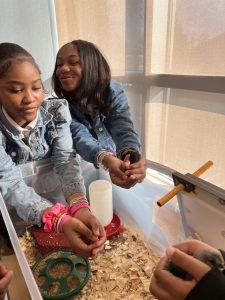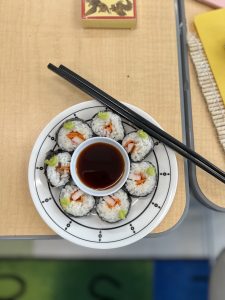 Making sure that children have the proper nutrition is essential to their development, health, and well-being. It’s also critical to their ability to learn.
Making sure that children have the proper nutrition is essential to their development, health, and well-being. It’s also critical to their ability to learn.
Research by the Centers for Disease Prevention and Control (CDC) reveals that adequate hydration may improve children’s cognitive function and that a healthy breakfast is associated with better cognitive and memory functions, reduced absenteeism, and improved mood. The CDC also notes that “schools are in a unique position to provide students with opportunities to learn about and practice healthy eating behaviors.”
The Baltimore Curriculum Project (BCP) provides just this opportunity with its unique Food for Life Curriculum, currently offered at City Springs Elementary / Middle School, Hampstead Hill Academy, and Pimlico Elementary / Middle School.
We spoke with Iman Williams, Pimlico’s Food and Nutrition Educator, on the program she started two years ago at Pimlico.
Q: How unique is BCP’s Food for Life Program?
 Iman: The Food for Life Program is geared to teaching Pre-K through middle school students about nutrition, healthy eating and teaching cooking skills.
Iman: The Food for Life Program is geared to teaching Pre-K through middle school students about nutrition, healthy eating and teaching cooking skills.
Pimlico’s program started two years ago when I was hired as Pimlico’s first-ever Food and Nutrition Educator. BCP’s Hampstead Hill was the first to establish a Food for Life program in 2005, which was taught by Ariel Demas. For the 2023-24 school year, Kristina Satterlee will be running the program and overseeing their community garden. City Springs started its program last year, taught by Steffany Smith. You can learn more about these two program’s curriculum by visitng Food Studies Institute.
Before I came to BCP, I was teaching a similar program as a food educator with Philadelphia’s Public Health Management Corporation. For four years, I taught nutrition and healthy eating in city schools, shelters, and food pantries. Philadelphia’s city schools now have a new nutrition requirement.
The Food for Life program is very unique in Baltimore, though. The programming I was doing in Philadelphia was not this intricate and comprehensive.
Q: How does the program work?
 Iman: At Pimlico, we work on a resource schedule, similar to an elective. Students get one resource per quarter. That means that I see the same group of kids for an entire quarter, for 45 days straight. By the end of the school year, every class and each student has had the Food for Life curriculum.
Iman: At Pimlico, we work on a resource schedule, similar to an elective. Students get one resource per quarter. That means that I see the same group of kids for an entire quarter, for 45 days straight. By the end of the school year, every class and each student has had the Food for Life curriculum.
Depending on the grade, I have a different curriculum. For kids second grade and younger, we do Eating the Alphabet, which means fresh foods for every letter of the alphabet: “A” is asparagus, apricot, and apple. Students get the letter with the sound and try new fresh fruits or vegetables. When they are in third through fifth grade, we introduce cooking and knife skills with safety knives. We start with easier recipes that focus on nutrition and the My Plate chart to make sure that they know all of the food groups.
In middle school, we spend about the first month solely on nutrition—vitamins, minerals, carbohydrates, proteins, all of those things. Then we move into an international menu and curriculum. Every couple of days, we switch to a different country and cook recipes from those different countries. We talk about geography and the culture of those countries and the food that grows in that part of the world. Then we make and eat recipes from those countries.
Q: Did you create the curriculum?
 Iman: I have a guided curriculum that I use that focuses on healthy eating with a cultural focus. The cultural parts come from that, but the nutrition lessons are created by me. Everywhere you look people are always giving people diet advice. But it’s actually much more intricate than people think. Every school is different and every population is different. You have to adjust things here and there to make it work for different groups of people.
Iman: I have a guided curriculum that I use that focuses on healthy eating with a cultural focus. The cultural parts come from that, but the nutrition lessons are created by me. Everywhere you look people are always giving people diet advice. But it’s actually much more intricate than people think. Every school is different and every population is different. You have to adjust things here and there to make it work for different groups of people.
My goal is to expand on these lessons and keep building their knowledge. What I’ve learned about teaching nutrition is that it takes three years for students to really understand the concepts. What food group does this food go in? What vitamins are in this food? It takes like three years to really remember.
We’re in year three now, and our students also know how to cut food safely and have basic kitchen skills. You don’t start a new program and have everybody know how to use a chef’s knife immediately. It just doesn’t work that way.
Q: Do your students have a favorite lesson?
 Iman: My kids love to do the sushi lesson. We have bamboo mats, chopsticks, soy sauce dishes, all of it. Most of our kids have never had sushi, but they’ve heard of it. This gives them a chance to use the nori or seaweed sheets, special sushi rice, and make their own roll. They love Asian food like the fried rice recipe, too.
Iman: My kids love to do the sushi lesson. We have bamboo mats, chopsticks, soy sauce dishes, all of it. Most of our kids have never had sushi, but they’ve heard of it. This gives them a chance to use the nori or seaweed sheets, special sushi rice, and make their own roll. They love Asian food like the fried rice recipe, too.
They also like making black bean tostadas from Mexico. The one thing about our Pimlico kids that makes them very special, is that they love spicy food. I’ve never seen anything like it in my life. In our school garden, we planted banana peppers, chili peppers, jalapenos, and Habaneros. This fall, it will be fun to watch them take a small bite and figure out if they like it.
Gardening lessons are my favorites. I take my younger kids out to the garden a lot for seed and soil lessons. We watch videos of how long it takes fruits and vegetables to grow. They love watching strawberries grow on youtube. We’ll plant seeds in the garden, and they think that the fruit will pop up in two days. I have to explain that it comes from the flower on the plant and it takes time. They love watering and caring for the garden.
This year, we raised chickens for three weeks in our classroom. We got an incubator, hatched baby chicks, and watched that process too.
Q: Tell us about Pimlico’s garden.
 Iman: During my first year in 2021, we talked a lot about the garden at Pimlico. I started in November that year, and it’s hard to get a garden started in late fall and winter. We really kicked it off in March 2022.
Iman: During my first year in 2021, we talked a lot about the garden at Pimlico. I started in November that year, and it’s hard to get a garden started in late fall and winter. We really kicked it off in March 2022.
Pimlico’s garden had been sitting untouched for a few years since the [new] school was renovated. We had to replace all the soil and basically start from scratch, put up a new fence, and create the curriculum to be used with the garden as a teaching tool.
Fresh fruits and vegetables in Park Heights are kind of hard to find. They’re not exactly readily available everywhere you go. A lot of my students may not have seen certain fresh fruits and vegetables. They learn from the garden that carrots don’t grow just orange. They grow purple, white, and all these different colors. I am so excited for them to have this experience.
Since January of this year, the garden has been full steam ahead. We have 16 giant feeding troughs that are our garden beds. Before the kids finished school this year, they planted the seedlings and put them in the garden. They saw our zucchini and watermelon start to grow a bit.
This summer, I am really testing what we can handle in the environment. Our goal is to eat food from the garden, so we don’t put pesticides on it. I am learning what grows well, what works, and what doesn’t. Things like cabbage and lettuce get eaten by our little caterpillar friends, but our melons, cucumbers, tomatoes, and zucchini are doing great.
We’re going to use the garden all four seasons. This fall, the students will plant potatoes, pumpkins, carrots, and sweet potatoes. In winter, we’ll grow lettuce, spinach, kale, and other indestructible winter crops.
We also have a lime tree that’s small enough to carry inside during the winter. We can take limes straight off the tree, which is really cool.
Q: What’s next at Pimlico for the Food for Life program?
 Iman: I am getting a paraeducator to help assist with my classes, which is incredible. I could not be more excited. We’ve also moved to a bigger classroom, and we will teach the full class at one time. Our old classroom was cramped, and we had to rotate half of the class in and out. Kids need and like the tactile lessons in Food for Life.
Iman: I am getting a paraeducator to help assist with my classes, which is incredible. I could not be more excited. We’ve also moved to a bigger classroom, and we will teach the full class at one time. Our old classroom was cramped, and we had to rotate half of the class in and out. Kids need and like the tactile lessons in Food for Life.
We’re hopefully going to get an oven, which is great and will allow me to expand the curriculum to add baking. I believe that baking is very important to learn because it’s a science, measuring, and a lot of math.
My goal is that next summer, we can add some summer camps focused on the garden and food and nutrition. We don’t have a greenhouse yet, but that’s the dream. Great Kids Farms, would definitely consult with us on that. It’s run through Baltimore City Public Schools Food and Nutrition Services. They have master gardeners who could help us put one in, but we would need to purchase it. But first, we want to focus on the garden and then get into the greenhouse.
Iman’s Fresh Food Tip for Parents for Healthier, Budget-Friendly Eating
If parents have SNAP benefits, go to a farmer’s market. You get your benefits doubled for fresh produce at a farmers’ markets called Double Up Food Bucks, which are amazing places to go and do something with your child. You can find fresh food and keep it cost friendly.
Find a Baltimore farmer’s market.
I also recommend cold recipes in the summer. You’d be surprised how far a fruit salad will go with kids. They love them! Let them pick the fruits that are available or on sale. Toss it together with some honey and mint, and you’re good to go.
Also, this summer, make sure kids are eating the really watery fruits and vegetables to stay hydrated, like watermelon, cucumbers, and tomatoes. And just try new food. If you see a fruit that you don’t know, get one. At Pimlico, a lot of my students had never had asparagus or cauliflower before. We’ve done guava and Passion Fruit.
About Iman Williams

B.S., Nutrition, Georgia State University
Master of Public Health, Social and Behavioral Science, Temple University
Food educator for four years with Philadelphia’s Public Health Management Corporation, teaching food and nutrition education in public schools, homeless shelters, food pantries, and other organizations
